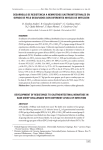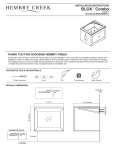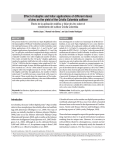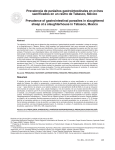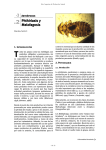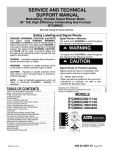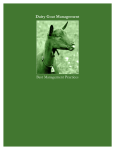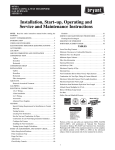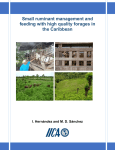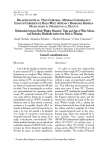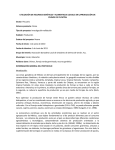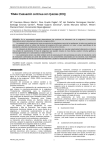Download efecto de la variación fenotípica en la resistencia de corderos
Transcript
EFECTO DE LA VARIACIÓN FENOTÍPICA EN LA RESISTENCIA DE CORDEROS PELIBUEY A LA INFESTACIÓN CON NEMATODOS GASTROINTESTINALES EFFECT OF THE PHENOTYPIC VARIATION IN THE RESISTANCE OF PELIBUEY LAMBS TO THE INFESTATION WITH GASTROINTESTINAL NEMATODES Rubén Morteo-Gómez1, Roberto González-Garduño2, Glafiro Torres-Hernández1, Guadalupe Nuncio-Ochoa3, Carlos M. Becerril-Pérez1, Jaime Gallegos-Sánchez1 y Emilio Aranda-Ibañez4 1 Programa de Ganadería. Colegio de Postgraduados. Instituto de Recursos Genéticos y Productividad. IREGEP. 56230, Km. 36.5 Carretera México-Texcoco. Montecillo, Estado de México. ([email protected]). 2Centro Regional Universitario del Sureste. Universidad Autónoma de Chapingo. Km. 7.5 Carretera Teapa-Vicente Guerrero. 3Instituto Tecnológico Agropecuario #28. 86270, Ocuiltzapotlán, Tabasco. 4Campus Tabasco. Colegio de Postgraduados. Apartado Postal 24. 86500, Cárdenas, Tabasco. RESUMEN ABSTRACT En México la parasitosis gastrointestinal es uno de los factores que causa alta mortalidad en ovinos y reduce la producción y rentabilidad de las explotaciones. El objetivo de este estudio fue determinar la variación fenotípica a la infestación con nematodos gastrointestinales en ovinos Pelibuey (Ovis aries) en la Sierra de Tabasco. Se utilizaron 38 corderos de cuatro a cinco meses de edad (20 hembras y 18 machos), con un peso promedio inicial de 12.6 kg. El estudio se llevó a cabo en dos etapas: la primera fue una infección natural (pradera), y la segunda fue natural+ artificial (pradera+larvas por vía oral). Cada 9 d se tomaron muestras de heces y sangre de los corderos, se midió la condición corporal, la coloración de la mucosa ocular y se pesaron. El número de huevos de nematodos por gramo de heces (hpg) se transformó a [Ln (hpg+1)]. El análisis estadístico se efectuó por el procedimiento GLM de SAS. Se encontraron diferencias significativas en los corderos a la infestación de nematodos; los corderos se clasificaron como resistentes y susceptibles a los nematodos, tomando como criterio de selección el promedio de hpg±dos errores estándar. Se encontraron 32.4% corderos resistentes y 32.4% susceptibles; el resto de los corderos (35.2%) se clasificó como un grupo intermedio. En comparación con los corderos susceptibles, los resistentes tuvieron al final una menor carga de nematodos (418±364 vs 5911±372 hpg), mayor peso corporal (16.9±0.23 vs 13.8±0.24 kg), y una calificación mayor en el color de la mucosa ocular (4.08±0.05 vs 3.5±0.05) y la condición corporal (3.9±0.04 vs 3.3±0.04), así como un hematocrito más alto (0.287±0.004 vs 0.243±0.004). Se concluye que la variabilidad fenotípica de ovinos Pelibuey influye en el número de huevos de nematodos por gramo de heces. In México, gastrointestinal parasitosis is one of the factors that causes a high mortality in sheep, and reduces production and profit of sheep operations. The objective of this study was to determine the phenotypic variation of Pelibuey sheep (Ovis aries) to infestation with gastrointestinal nematodes in the highlands of Tabasco. Thirty-eight Pelibuey lambs, four to five months old, were utilized (20 ewes and 18 rams), with 12.6 kg initial body weight. The study was performed in two stages: the first was a natural infection (pasture), and the second was natural+artificial (pasture +orally administered larvae). Every 9 d, faecal and blood samples were taken from the lambs, body condition and color of ocular mucous were assessed, and lambs were weighed. The number of nematode eggs per gram of faeces (epg) was transformed to [Ln (epg+1)]. Statistical analysis was carried out with the GLM procedure of SAS. Significant differences were found in the nematode infestation of the lambs, which were classified as resistant or susceptible to nematodes, using the average of epg±two standard errors as the selection criteria. Of the lambs thus classified, 32.4% were resistant and 32.4% susceptible; the rest (35.2%) was classified as an intermediate group. Compared to susceptible lambs, resistant ones had a lower infestation of nematodes (418±364 vs 5911±372epg), greater body weight (16.9±0.23 vs 13.8±0.24 kg), a higher score for color of the ocular mucous (4.0±0.05 vs 3.5±0.05) and body condition (3.9±0.04 vs 3.3±0.04), as well as a higher hematocrit (0.287±0.004 vs 0.243±0.004). It is concluded that the phenotypic variability of Pelibuey lambs affects the number of eggs of nematodes per gram of faeces. Key words: Lambs, eggs per gram of faeces, artificial infestation, gastrointestinal parasites, resistance. Palabras clave: Corderos, huevos por gramo de heces, infestación artificial, parásitos gastrointestinales, resistencia. INTRODUCTION I n grazing production systems, the diseases produced by gastrointestinal nematodes (gin) more frequently affect sheep, and represent a limiting factor in Recibido: Octubre, 2003. Aprobado: Junio, 2004. Publicado como ARTÍCULO en Agrociencia 38: 395-404. 2004. 395 396 AGROCIENCIA VOLUMEN 38, NÚMERO 4, JULIO-AGOSTO 2004 INTRODUCCIÓN E n los sistemas de producción en pastoreo, las enfermedades producidas por nematodos gastrointestinales (ngi) afectan con mayor frecuencia al ganado ovino y representan un factor limitativo en la producción (Waller, 1994). Tradicionalmente el control de parásitos gastroentéricos se ha hecho mediante antihelmínticos (Vázquez et al., 1984). Sin embargo, en ocasiones se desarrollan poblaciones de nematodos resistentes a los antiparasitarios y los residuos de los químicos se acumulan en los tejidos de los animales, con posibles consecuencias adversas para la salud humana (Woolaston y Baker, 1996). Estos problemas han dado pauta para desarrollar métodos de control de parásitos internos que sean menos dependientes de los antihelmínticos, tales como la cría de ovinos genéticamente resistentes (Bisset y Morris, 1996; Miller et al., 1998). La variación genética de la resistencia al nematodo Haemonchus contortus entre y dentro de razas y su utilización para selección de razas de ovinos resistentes, se está utilizando en programas de mejoramiento genético principalmente en Australia y Nueva Zelanda (Gray, 1997; Hooda et al., 1999). Se han reportado variaciones importantes en la resistencia a nematodos gastrointestinales entre diferentes razas ovinas; razas de pelo como la Red Massai (Preston y Allonby, 1979), Florida, Saint Croix, Barbados Blackbelly y Navajo (Courtney et al., 1985), son más resistentes a nematodos que las razas europeas. El número de huevos de ngi en las heces se ha adoptado como una medida indirecta de la resistencia del huésped y su índice de herencia se ha determinado en varias razas de ovinos (Woolaston et al., 1991). Los mecanismos responsables de la resistencia no se han aclarado; dentro de los factores asociados están el estado nutricional, edad, sexo, raza, tipo de hemoglobina, respuesta eosinofílica, presencia de ciertos antígenos leucocitarios o de algunos genes (Hohenhaus y Outteridge, 1995). El objetivo de la presente investigación fue determinar la variación fenotípica en corderos Pelibuey a la resistencia a nematodos gastrointestinales mediante conteos de huevos de nematodos en heces, el peso vivo, hematocrito, condición corporal y color de la mucosa ocular, así como identificar los géneros de nematodos adultos. MATERIALES Y MÉTODOS Localización del experimento El experimento se llevó a cabo en el Centro Regional Universitario del Sureste (CRUSE) de la Universidad Autónoma Chapingo, en San José Puyacatengo, Municipio de Teapa, Tabasco, que se ubica en el km 7.5 de la carretera estatal Teapa-Ranchería Vicente Guerrero Lerma, production (Waller, 1994). Traditionally, the control of gastroenteric parasites has been carried out by means of anhelmintics (Vázquez et al., 1984). However, occasionally populations of nematodes develop that are resistant to the antiparasitics, and the chemical residues accumulate in the animal tissue, with possible adverse consequences for human health (Woolaston and Baker, 1996). These problems have set the guidelines for developing methods for controling internal parasites which are less dependent on the anhelmintics, such as the breeding of genetically resistant sheep (Bisset and Morris, 1996; Miller et al., 1998). The genetic variation of resistance to the nematode Haemonchus contortus among and within breeds, and its use in the selection of resistant races of sheep, is being applied in genetic improvement programs, principally in Australia and New Zeland (Gray, 1997; Hooda et al., 1999). Important variations have been reported in the resistance to gastrointestinal nematodes among different breeds of sheep; hairy breeds such as Red Massai (Preston and Allonby, 1979), Florida, Saint Croix, Barbados Blackbelly and Navajo (Courtney et al., 1985), are more resistant to nematodes than the European breeds. The number of gin eggs in the faeces has been adopted as an indirect measurement of the resistance of the host, and its heritability index has been determined in various breeds of sheep (Woolaston et al., 1991). The mechanisms responsible for the resistance have not been elucidated; among the associated factors are the nutritional state, age, sex, breed, type of hemoglobin, eosinophilic response, presence of certain leukocitic antigens or of some genes (Hohenhaus and Outteridge, 1995). The objective of this research was to determine the phenotypic variation in Pelibuey lambs to the resistance to gastrointestinal nematodes through counts of nematode eggs in faeces, live weight, hematocrit, body condition and color of the ocular mucous, as well as to identify the genera of adult nematodes. MATERIALS AND METHODS Location of the experiment The experiment was carried out at the Centro Regional Universitario del Sureste (CRUSE) of the Universidad Autónoma Chapingo, in San José Puyacatengo, municipality of Teapa, Tabasco, which is located at km. 7.5 on the Teapa-Ranchería Vicente Guerrero Lerma state highway, at the coordinates 17o 34’ N and 92o 56’ W. The climate is Af (m)w”(i)g, which corresponds to warm humid with rains all year, with a percentage of winter rain with respect to the least annual of 18%, a mean annual precipitation of 3975.5 mm, mean annual temperature of 25.8 oC and an altitude of 60 m (García, 1988). MORTEO-GÓMEZ et al.: RESISTENCIA DE CORDEROS PELIBUEY A NEMATODOS GASTROINTESTINALES con coordenadas 17o 34’ N y 92o 56’ O. El clima es Af (m)w’’(i)g, que corresponde a cálido húmedo con lluvias todo el año, con un porcentaje de lluvia invernal respecto a la anual menor de 18%, una precipitación media anual de 3975.5 mm, temperatura media anual de 25.8 oC y una altura de 60 m (García, 1988). Descripción del experimento El periodo experimental fue de mayo a octubre de 2002. Se utilizaron 38 corderos Pelibuey (20 hembras y 18 machos), de cuatro a cinco meses de edad, peso medio inicial de 12.6 kg, destetados a los tres meses. A finales de la primera etapa se registró la muerte de un cordero. La procedencia de los corderos fue la siguiente: 18 del Instituto Tecnológico Agropecuario (ITA) No. 28 de Tabasco, y 20 del CRUSE; los pesos medios iniciales fueron 10.8 y 14.7 kg. El experimento se concluyó en dos etapas, la primera de 63 d y la segunda de 58 d. Cada 9 d se recolectó una muestra de heces y sangre de cada cordero, se midió la condición corporal en una escala de 0 a 5 (Pollot y Kilkenny, 1976), la coloración de la mucosa ocular en una escala de 1 a 5 por el método de la FAMACHA (Van Wyk y Bath, 2002) y los animales se pesaron; las mismas variables se midieron en la segunda etapa. Antes de la primera etapa los corderos se mantuvieron encerrados tres semanas; recibieron un concentrado comercial con 14% de proteína cruda, alfalfa (Medicago sativa) achicalada y agua a libre acceso. Dos días antes de cada etapa todos los corderos recibieron un antiparasitario (Levamisol 7.5 mg kg−1 peso vivo). Los corderos pastorearon durante la mañana en praderas de Estrella de África (Cynodon plectostachyus) y eran encerrados cada tarde. La efectividad del antiparasitario en cada etapa se confirmó, porque los resultados de conteos fecales efectuados 8 y 15 d después de la aplicación post-desparasitación indicaron cero huevos de nematodos en todos los corderos. La primera etapa consistió en una infección natural (en el potrero) con ngi. Al finalizar ésta, los corderos recibieron antiparasitario y se mantuvieron encerrados tres semanas antes de la siguiente etapa. Como se esperaba, los corderos iniciaron la eliminación de huevos de nematodos a los 21-25 d de iniciado el pastoreo. La segunda etapa consistió en una infección artificial: al inicio, y 15 d después, cada cordero recibió vía oral 3000 larvas infestantes (L3) de una mezcla de nematodos gastrointestinales, en su mayoría Haemonchus (86%), más la infección natural de los potreros. Las muestras de heces (5 a 10 g por cordero) se recolectaron directamente del recto y se colocaron en bolsas de plástico, las cuales se marcaron con el número del cordero correspondiente. El número de huevos de nematodo por gramo de heces (hpg) se contabilizó usando la técnica de McMaster modificada (Thienpont et al., 1986), en la cual cada huevo de nematodo representa 50 huevos g−1. En cada muestreo se agruparon todas las muestras de heces para cultivarlas por el método de Curticelli modificado (Niec, 1968), para producir larvas L3 e identificar los géneros de nematodos presentes. Para determinar el porcentaje de hematocrito se tomaron muestras de sangre por punción de la vena yugular utilizando tubos vacutainer con EDTA como anticoagulante (Coffin, 1986) y se prepararon los capilares para colocarlos en una centrífuga (Rolco, modelo CH 24, Industria Argentina) durante 5 min a 13 000 rpm. 397 Description of the experiment The experimental period was from May to October of 2002. Thirtyeight Pelibuey lambs were used (20 ewes and 18 rams), four to five months old, mean initial weight 12.6 kg, weaned at three months of age. At the end of the first stage, the death of a lamb was recorded. The origen of the lambs was as follows: 18 from the Instituto Tecnológico Agropecuario (ITA) No. 28 of Tabasco, and 20 from the CRUSE; the initial mean weight were 10.8 and 14.7 kg. The experiment concluded in two stages; the first of 63 d and the second of 58 d. Every 9 d a sample of faeces and blood was taken from each lamb, the body condition was measured on a scale of 0 to 5 (Pollot and Kilkenny, 1976), the coloration of the ocular mucous on a scale of 1 to 5 by the FAMACHA method (Van Wyk and Bath, 2002), and the animals were weighed; the same variables were measured in the second stage. Before the first stage, the lambs were isolated for three weeks; received a commercial concentrate with 14% crude protein, dried alfalfa (Medicago sativa) and had free access to water. Two days before each stage, all of the lambs received an antiparasitic (Levamisol 7.5 mg kg−1 live weight). The lambs grazed during the morning in pastures of African Star (Cynodon plectostachyus) and were enclosed each afternoon. The effectiveness of the antiparasitic in each stage was confirmed, because the results of faecal counts performed 8 and 15 d after the post-deparasitization application indicated zero nematode eggs in all of the lambs. The first stage consisted of a natural infection (in the pasture grounds) with gin. At the end of this stage the lambs received an antiparasitic and were enclosed for three weeks before the following stage. As expected, the lambs began the elimination of nematode eggs 21-25 d after the start of grazing. The second stage consisted of an artificial infection: at the start, and 15 d later, each lamb received orally 3000 infesting larvae (L3) of a mixture of gastrointestinal nematodes, the majority of which were Haemonchus (86%), along with the natural infection of the pasture grounds. The faecal samples (5 to 10 g per lamb) were collected directly from the rectum and placed in plastic bags, which were marked with the number of the corresponding lamb. The number of nematode eggs per gram of faeces (epg) was counted using the modified McMaster technique (Thienpont et al., 1986), in which each nematode egg represents 50 eggs g−1. In each sampling, all of the faecal samples were grouped to be cultivated by the modified Curticelli method (Niec, 1968), to produce larvae L3 and to identify the genera of nematodes present. To determine the percentage of hematocrit, blood samples were taken by puncturing the jugular vein using vacutainer tubes with EDTA as an anticoagulant (Coffin, 1986), and the capillaries were prepared to be placed in a centrifuge (Rolco, model CH 24, Industria Argentina) during 5 min at 13 000 rpm. Statistical analysis The data were analyzed with the GLM procedure (SAS, 1998). The number of nematode eggs in faeces was transformed to [Ln (epg+1)] to homogenize the variance and thus obtain an approximation of normal distribution (Bouix et al., 1998). The statistical model was: 398 AGROCIENCIA VOLUMEN 38, NÚMERO 4, JULIO-AGOSTO 2004 Análisis estadístico Yijklm = µ + Li + A ( L ) j (i ) + Ek + ( E × L )ik Los datos se analizaron con el procedimiento GLM (SAS, 1998). El número de huevos de nematodos en heces se transformó a [Ln (hpg+1)] para homogeneizar la varianza y obtener una aproximación a la distribución normal (Bouix et al., 1998). El modelo estadístico fue: Yijklm = µ + Li + A ( L ) j (i ) + Ek + ( E × L )ik +S ( E × L )l (ki ) + E × A ( L )kj (i ) + ξijklm donde Yijklm : variable respuesta (número de huevos por gramo de heces, etc.), µ: media general; Li : efecto de la i-ésima localidad (ITA, CRUSE); A(L)j(i) : efecto del j-ésimo animal anidado dentro de localidad (j=1...37); Ek : efecto de la k-ésima etapa (k= 1, 2); (E×L)ik : efecto de la interacción etapa de muestreo por localidad; S(E×L)l(ki): efecto de la l-ésima semana de muestreo anidada en la etapa por localidad (l=1,...7); E×A/Lkj(i) : efecto de la interacción etapa por animal anidado dentro de localidad; ξijklm : error aleatorio, NID 0, σ 2e . ( ) En un análisis preliminar se incluyó el efecto del sexo en todas las variables analizadas; sin embargo, se eliminó posteriormente del modelo debido a que no mostró un efecto significativo. La significancia estadística debida a localidad se probó tomando como denominador el efecto de animal anidado dentro de localidad, mientras que todos los demás efectos, incluyendo las interacciones, se probaron contra el error aleatorio. RESULTADOS Y DISCUSIÓN Efecto de localidad Se encontraron diferencias significativas al final del experimento (Cuadro 1) a favor de los corderos provenientes del CRUSE en peso vivo, color de la mucosa ocular, condición corporal y hematocrito (Cuadro 2). Tales diferencias se pueden atribuir a un mejor manejo (principalmente alimentación) de los corderos del CRUSE antes del experimento, ya que su peso vivo inicial fue mayor. +S ( E × L )l ( ki ) + E × A ( L )kj (i ) + ξijklm where Yijklm : variable response (number of eggs per gram of faeces, etc.); µ: general mean; Li : effect of the i-th location (ITA, CRUSE); A(L)j(i): effect of the j-th animal nested within location (j=1...37); Ek : effect of the k-th stage (k= 1, 2); (E×L)ik : effect of the sampling stage interaction per location; S(E×L)l(ki) : effect of the l-th week of sampling nested in the stage per location (l=1,...7); E×A/Lkj(i) : effect of the stage per animal interaction nested within location; ξijklm: random error, NID 0, σ 2e . ( ) A preliminary analysis included the effect of sex on all of the variables analyzed; however, it was later removed from the model due to the fact that it did not show a significant effect. The statistical significance due to location was tested using as a denominator the effect of animal nested within location, whereas all of the other effects, including the interactions, were tested against the random error. RESULTS AND DISCUSSION Location effect At the end of the experiment, significant differences were found (Table 1) in favor of the lambs from the CRUSE in live weight, color of the ocular mucous, body condition and hematocrit (Table 2). Such differences can be attributed to a better management (principally feeding) of the CRUSE lambs prior to the experiment, given that their initial live weight was greater. Stage effect No significant differences were found in the number of epg between the stages with natural and artificial infection (Table 3). The case of live weight was different, as the result was similar to that reported by Notter et al. (2003) when evaluating hair and wool sheep. The Cuadro 1. Cuadrados medios de las variables en corderos Pelibuey. Table 1. Mean squares of the variables in Pelibuey lambs. Característica Fuente de variación Grados de libertad Ln(HPG+1) Localidad (L) Animal /L Etapa (E) E×L Semana/E×L E×Animal/L Error 1 35 1 1 20 35 245 67.92 33.73** 8.20 33.21* 65.08** 7.91** 2.74 PV CMO CC 877.89** 79.76** 617.62* 1.12 16.73** 4.62** 0.65 5.49* 1.57** 28.39** 2.13* 2.60** 0.59** 0.23 21.39** 1.45** 10.91** 1.80** 2.21** 0.30** 0.085 H 0.204** 0.009** 0.011* 0.000 0.013** 0.005** 0.001 HPG = huevos por gramo de heces; PV = peso vivo; CMO = color de la mucosa ocular; CC = condición corporal; H = hematocrito. ** p≤0.01, * p≤0.05. MORTEO-GÓMEZ et al.: RESISTENCIA DE CORDEROS PELIBUEY A NEMATODOS GASTROINTESTINALES 399 Cuadro 2. Medias de cuadrados mínimos ± error estándar de las variables por localidad de procedencia. Table 2. Least-squares means ± standard error of the variables per place of origen. Localidad HPG CRUSE ITA 1806 ± 223a 3480 ± 242a PV CMO CC H 16.82 ± 0.05a 13.86 ± 0.06b 3.9 ± 0.03a 3.7 ± 0.03b 3.8 ± 0.02a 3.4 ± 0.02b 0.289 ± 0.002a 0.246 ± 0.002b HPG = huevos por gramo de heces; PV = peso vivo; CMO = color de la mucosa ocular; CC = condición corporal; H = hematocrito. a, b medias con literales distintas en cada columna son diferentes (p≤0.05). Efecto de la etapa No se encontraron diferencias significativas en el número de hpg entre las etapas con infección natural y artificial (Cuadro 3). El peso vivo fue diferente, resultado similar al reportado por Notter et al. (2003) al evaluar ovinos de pelo y de lana. Las diferencias del color de la mucosa ocular y la condición corporal, posiblemente estuvieron influenciadas por la edad y la ganancia de peso de los corderos Interacción etapa por localidad Los corderos del CRUSE mostraron menor número de hpg que los del ITA en las dos etapas. En la primera etapa (infección natural) tuvieron una media de 1707±298 y los del ITA 3123±323 hpg (p≤0.01); en la segunda etapa (infección artificial) los valores promediaron 1905±333 hpg y 3837±361 hpg (p≤0.01), para los corderos del CRUSE y del ITA (Figura 1). La interacción etapa por localidad afectó el color de la mucosa ocular (p≤0.05) y la condición corporal (p≤0.01) (Figura 2). Los corderos del ITA tuvieron una mejor calificación en la coloración de la mucosa ocular que los del CRUSE en la primera etapa, mientras que en la segunda la calificación no fue diferente. Los corderos del CRUSE tuvieron mejor calificación de condición corporal que los del ITA en ambas etapas, aunque la diferencia fue mayor en la segunda etapa. Efecto de la semana de muestreo En la primera etapa los conteos de huevos de nematodos fueron bajos hasta el día 43, y altos en los días 56 y 63 (p≤0.05) (Cuadro 4). En la segunda etapa differences in color of the ocular mucous and body condition were possibly influenced by the age and weight gain of the lambs. Stage per location interaction The CRUSE lambs showed a lower number of epg than those from ITA in both stages. In the first stage (natural infection), they had a mean of 1707±298, while those of the ITA had 3123±323 epg (p≤0.01); in the second stage (artificial infection), the values averaged 1905±333 epg and 3837±361 epg (p≤0.01), for the lambs of the CRUSE and of the ITA (Figure 1). The stage per location interaction affected the color of the ocular mucous (p≤0.05) and the body condition (p≤0.01) (Figure 2). The ITA lambs had a higher score in the coloration of the ocular mucous than those of the CRUSE in the first stage, whereas, in the second, the score was not different. The CRUSE lambs had a better score in body condition than those of the ITA in both stages, although the difference was greater in the second stage. Effect of the week of sampling In the first stage the counts of nematode eggs were low until day 43, and high on days 56 and 63 (p≤0.05) (Table 4). In the second stage the egg counts were high from day 27, perhaps because of the quantity of larvae administered (6000); this result is similar to that reported by Notter et al. (2003), and Gamble and Zajac (1992). The live weight in the first stage increased from the start until day 28 (p≤0.05), when the lambs were free of parasites, decreased on day 43 (p≤0.05), increased on day 56, and remained constant until day 63; a similar situation ocurred in the second stage. The effects were Cuadro 3. Medias de cuadrados mínimos ± error estándar de las variables en corderos Pelibuey por etapa. Table 3. Least-squares means ± standard error of the variables in Pelibuey lambs per stage. Etapa Infección natural Infección artificial (HPG) 2415 ± 220a 2871 ± 246a PV (kg) 14.1 ± 0.05a 16.58 ± 0.06b CMO 3.54 ± 0.03a 4.04 ± 0.03b CC 3.44 ± 0.02a 3.76 ± 0.02b H 0.273 ± 0.002a 0.263 ± 0.002b HPG = huevos por gramo de heces; PV = peso vivo; CMO = color de la mucosa ocular; CC = condición corporal; H = hematocrito. a, b medias con literales distintas en cada columna son diferentes (p≤0.05). AGROCIENCIA VOLUMEN 38, NÚMERO 4, JULIO-AGOSTO 2004 3.9 4.3 4000 4.2 3500 4.1 Color de la mucosa Huevos por gramo de heces 4500 3000 2500 2000 1500 CRUSE-color mucosa CRUSE-condición corporal ITA-color mucosa ITA-condición corporal 3.8 3.7 4.0 3.9 3.6 3.8 3.5 3.7 Condición corporal 400 3.4 CRUSE ITA 1000 3.6 500 3.5 0 3.4 1 3.3 3.2 1 2 2 Etapa Etapa Figura 1. Interacción etapa por localidad en el número de huevos de nematodos gastrointestinales por gramo de heces. Figure 1. Stage per location interaction in the number of eggs of gastrointestinal nematodes per gram of faeces. Figura 2. Interacción etapa por localidad en el color de la mucosa ocular y la condición corporal de corderos Pelibuey. Figure 2. Stage per location interaction in the color of the ocular mucous and body condition of Pelibuey lambs. los conteos de hpg fueron altos desde el día 27, tal vez por la cantidad de larvas administradas (6000); este resultado es similar al reportado por Notter et al. (2003) y Gamble y Zajac (1992). El peso vivo en la primera etapa aumentó desde el inicio hasta el día 28 (p≤0.05), cuando los corderos estuvieron libres de parásitos, disminuyó el día 43 (p≤0.05), aumentó el día 56, y se mantuvo así hasta el día 63; una situación similar ocurrió en la segunda etapa. Los efectos fueron semejantes para el color de la mucosa ocular y la condición corporal en ambas etapas. El hematocrito se mantuvo elevado hasta el día 28, disminuyó el día 43 y se mantuvo durante la primera etapa; estuvo alto al principio de la segunda etapa y el día 27 bajó drásticamente (p≤0.05) como consecuencia de la infección artificial (Cuadro 4). similar for the color of the ocular mucose and body condition in both stages. The hematocrit remained high until day 28, decreased on day 43 and was maintained during the first stage, it was high at the beginning of the second stage, and on day 27, decreased drastically (p≤0.05) as a result of the artificial infection (Table 4). A similar situation was found in the studies of Amarante et al. (1999) and Díaz et al. (2000), since the lowest values of hematocrit corresponded to the highest values of the number of eggs eliminated in the faeces. Stage per animal interaction A significant effect was observed in the elimination of eggs in faeces between stages, and was more pronounced in the ITA lambs. In the lambs with a low Cuadro 4. Medias de cuadrados mínimos ± error estándar de las variables por semana de muestreo y por etapa en corderos Pelibuey. Table 4. Least-squares means ± standard error of the variables per week of sampling and per stage in Pelibuey lambs. Etapa Día HPG PV CMO Primera 1 28 38 43 56 63 1 27 34 41 58 0 95 ± 491a 236 ± 491a 1450 ± 491ad 3235 ± 491bde 7059 ± 491c 0 2157 ± 491de 2741 ± 491de 3348 ± 491e 3239 ± 491e 12.7 ± 0.13f 14.7 ± 0.13cd — 14.0 ± 0.13e 14.5 ± 0.13d 14.3 ± 0.13de 15.1 ± 0.13c 17.6 ± 0.13a — 17.2 ± 0.13b 17.1 ± 0.13b 3.0 ± 0.08e 4.2 ± 0.08ab — 4.0 ± 0.08bc 3.5 ± 0.08d 3.3 ± 0.08d 4.4 ± 0.08a 3.9 ± 0.08c 4.0 ± 0.08bc 4.0 ± 0.08bc 3.9 ± 0.08c Segunda CC 2.9 ± 0.05f 4.0 ± 0.05ab — 3.9 ± 0.05b 3.3 ± 0.05e 3.3 ± 0.05e 4.1 ± 0.05a 3.7 ± 0.05c 3.6 ± 0.05cd 3.5 ± 0.05d 3.6 ± 0.05cd H 0.272 ± 0.005c 0.313 ± 0.005a — 0.278 ± 0.005c 0.248 ± 0.005de 0.242 ± 0.005de 0.293 ± 0.005b 0.248 ± 0.005de 0.247 ± 0.005de 0.238 ± 0.005e 0.255 ± 0.005d HPG = huevos por gramo de heces; PV = peso vivo; CMO = color de la mucosa ocular; CC = condición corporal; H = Hematocrito; — = no se tomaron datos; a, b, c, d, e, f : medias con literales distintas en cada columna son diferentes (p≤0.05). MORTEO-GÓMEZ et al.: RESISTENCIA DE CORDEROS PELIBUEY A NEMATODOS GASTROINTESTINALES Una situación similar se encontró en los estudios de Amarante et al. (1999) y Díaz et al. (2000), ya que los menores valores de hematocrito correspondieron a los mayores valores del número de huevos eliminados en las heces. Interacción etapa por animal Se observó un efecto significativo en la eliminación de huevos en heces entre etapas, y fue más marcado en los corderos del ITA. En los corderos con bajo conteo de huevos de ngi en la etapa con infección natural se incrementó el conteo cuando la infección fue artificial; en la mayoría de los corderos del CRUSE los conteos de hpg fueron bajos en ambas etapas. Este comportamiento podría atribuirse a que los corderos del CRUSE habían estado expuestos a los nematodos locales y tal vez adquirieron cierta inmunidad. Casi todos los corderos incrementaron su peso vivo, excepto aquellos con altas cargas parasitarias que sólo lo mantuvieron, lo cual es similar a lo ocurrido con el color de la mucosa ocular. En cuanto a la condición corporal, los corderos más afectados fueron los del ITA durante la segunda etapa. En el hematocrito ambos rebaños fueron severamente afectados durante la etapa de infección artificial, como consecuencia de la cantidad de larvas administradas. Selección de corderos resistentes y susceptibles La selección de corderos resistentes y susceptibles a los parásitos gastrointestinales se efectuó tomando como criterio el promedio general de hpg de las dos etapas de muestreo (promedio total de hpg± dos errores estándar). Se excluyeron del análisis los dos primeros muestreos de cada etapa (con valores cercanos a cero), de acuerdo con el criterio recomendado por Notter et al. (2003). Así, se encontraron 12 corderos resistentes y 12 susceptibles, y 13 corderos fueron considerados como un grupo intermedio (Cuadro 5). El número de huevos en las heces se ha utilizado como una medida parasitológica en la selección de ovinos resistentes a infecciones por nematodos (Gray, 1991; Sreter et al., 1994), y está relacionado con el número total de trichostrongylidos (Bisset et al., 1991) y en particular con Haemonchus contortus (Roberts y Swan, 1981). Por tanto, su uso en el conteo de huevos en heces es justificado y también está correlacionado positivamente con la carga de nematodos adultos, como indicador de resistencia a los parásitos. Aunque en este estudio no se consideró el origen genético como fuente de variación, la variación genética dentro de raza ha sido documentada (Gray et al., 1995) y está influida por factores genéticos y ambientales (Barger y Dash, 1987; Wakelin, 1992). El porcentaje de 401 gin egg count in the natural infection stage, the count increased when the infection was artificial; in the majority of the CRUSE lambs, the egg counts were low in both stages. This behavior could be attributed to the fact that the CRUSE lambs had been exposed to the local nematodes and perhaps had acquired a certain degree of immunity. Almost all of the lambs increased their live weight, except those with heavy burdens of parasites, which only maintained their weight, which is similar to what occurred with the color of the ocular mucous. With respect to body condition, the most affected lambs were those of the ITA during the second stage. In the hematocrit, both flocks were severely affected during the stage of artificial infection, as a consequence of the amount of larvae administered. Selection of resistant and susceptible lambs The selection of lambs resistant and susceptible to gastrointestinal parasites was carried out using as a criterion the general average of epg of the two stages of sampling (total average of epg ± two standard errors). The first two samplings of each stage (with values close to zero) were excluded from the analysis, according to the criteria recommended by Notter et al. (2003). Thus, 12 resistant, and 12 susceptible lambs were found, and 13 lambs were considered as an intermendiate group (Table 5). The number of eggs in the faeces has been used as a parasitological measurement in the selection of sheep resistant to nematode infections (Gray, 1991; Sreter et al., 1994), and is related to the total number of trichostrongylids (Brisset et al., 1991), and in particular, to Haemonchus contortus (Roberts and Swan, 1981). Therefore, its use in the faecal egg count is justified, and is also positively correlated to the load of adult nematodes, as an indicator of resistance to the parasites. Although in this study genetic origen was not considered as a source of variation, the genetic variation within the breed has been documented (Gray et al., 1995), and is influenced by genetic and environmental factors (Barger and Dash, 1987; Wakelin, 1992). The percentage of resistant lambs in this study (32.4%) is similar to that obtained by Figueroa Castillo et al. (2000), who found 37.5%. However, with respect to susceptible lambs in the present study, 32.4% were found, and Figueroa Castillo et al. (2000) obtained 62.5%, which is attributed to the different selection criteria of lambs used by these authors, whose base was the average minus the standard error. Of the susceptible lambs, four were rams (33.33%) and eight were ewes (66.67%). Of the total number of resistant lambs, nine were female (75%) and three male 402 AGROCIENCIA VOLUMEN 38, NÚMERO 4, JULIO-AGOSTO 2004 Cuadro 5. Medias de cuadrados mínimos ± error estándar de las variables en corderos Pelibuey resistentes, susceptibles e intermedios. Table 5. Least-squares means ± standard error of the variables in resistant, susceptible and intermediate Pelibuey lambs. Grupo N Resistentes Susceptibles Intermedio 12 12 13 HPG 418 ± 364a 5911 ± 372c 1384 ± 351b PV CMO CC H 16.9 ± 0.23a 13.8 ± 0.24c 15.4 ± 0.23b 4.0 ± 0.05a 3.5 ± 0.05c 3.8 ± 0.05b 3.9 ± 0.04a 3.3 ± 0.04c 3.6 ± 0.04b 0.287 ± 0.004a 0.243 ± 0.004c 0.270 ± 0.003b HPG= huevos por gramo de heces; PV= peso vivo; CMO= color de la mucosa ocular; CC= condición corporal; H= hematocrito; a,b,c: medias con literales distintas en cada columna son diferentes (p≤0.05). corderos resistentes en este estudio (32.4%) es semejante al obtenido por Figueroa Castillo et al. (2000), quienes encontraron 37.5%. Pero en cuanto a corderos susceptibles, en el presente estudio se encontró 32.4% y Figueroa Castillo et al. (2000) obtuvieron 62.5%, lo que se atribuye al criterio diferente de selección de corderos usado por estos autores, cuya base fue el promedio menos el error estándar. De los corderos susceptibles cuatro fueron machos (33.33%) y ocho hembras (66.67%). Del total de corderos resistentes nueve fueron hembras (75%) y tres machos (25%), lo que sugiere que las hembras manifiestan una mayor resistencia a los parásitos gastrointestinales que los machos. En el presente estudio no se incluyó el efecto del sexo en las variables analizadas porque no fue significativo. Sin embargo, Eady et al. (2003) mencionaron que la mayor resistencia de las hembras a los parásitos gastrointestinales en comparación con los machos es una observación común de los criadores de ovinos y coincide con otros estudios (Courtney et al., 1985; Barger, 1993; Díaz et al., 2000). El promedio de la carga de hpg de los corderos resistentes en este estudio (418±364 hpg) no es muy diferente al promedio (237 hpg) que obtuvieron Kahn et al. (2003) en ovinos Merino. Además de la menor carga de hpg de los corderos resistentes, éstos fueron más pesados, tuvieron un hematocrito más alto, un mejor color de la mucosa ocular y mejor condición corporal que los susceptibles e intermedios (Cuadro 5). En los coprocultivos, Haemonchus contortus fue el parásito más frecuente (73%), seguido por Oesophagostomum (19%), Cooperia (6%), y Ostertagia (2%). Esto coincide con los resultados obtenidos por Díaz et al. (2000) con 78% para H. contortus, y por Baker (1995) en ovinos Red Maasai (66% de Haemonchus) en la región costera de Kenya, África. CONCLUSIONES Se encontró una diferente respuesta fenotípica entre los corderos Pelibuey en la eliminación de huevos de nematodos gastrointestinales en las heces. Con base en esta variable se detectó un grupo resistente, uno susceptible y otro intermedio. (25%), which suggests that the females manifested a greater resistance to gastrointestinal parasites than males. In the present study, the effect of sex on the variables analyzed was not included, because it was not significant. However, Eady et al. (2003) mentioned that the higher resistance of the ewes to the gastrointestinal parasites with respect to the rams is a common observation of the sheep breeders, and coincides with other studies (Courtney et al., 1985; Barger, 1993; Díaz et al., 2000). The average of the epg load of resistant lambs in this study (418±364 epg) is not very different from the average (237epg) obtained by Kahn et al. (2003) in Merino sheep. In addition to the lower egg load of the resistant sheep, these were heavier, had a higher hematocrit, better color of the ocular mucous and better body condition than the susceptible and intermediate lambs (Table 5). In the faecal cultures, Haemonchus contortus was the most frequent parasite (73%), followed by Oesophagostomum (19%), Cooperia (6%), and Ostertagia (2%). This coincides with the results obtained by Díaz et al. (2000) with 78% for H. Contortus, and by Baker (1995) in Red Massai sheep (66% Haemonchus) in the coastal region of Kenya, África. CONCLUSIONS A different phenotypic response was found among Pelibuey lambs in the elimination of gastrointestinal nematode eggs in the faeces. Based on this variable, a resistant group was detected, as well as a one susceptible and an intermediate. In addition to having lower counts of eggs per gram of faeces with respect to susceptible lambs, the resistant lambs had a greater final live weight, received higher scores for the color of the ocular mucous and body condition, and a higher percentage of hematocrit. The parasites most frequently found in the faecal cultures were of the species Haemonchus contortus, followed by the genera Oesphagostomum, Cooperia and Ostatagia. —End of the English version— MORTEO-GÓMEZ et al.: RESISTENCIA DE CORDEROS PELIBUEY A NEMATODOS GASTROINTESTINALES Además de tener menores conteos de huevos por gramo de heces en comparación con los corderos que resultaron susceptibles, los corderos resistentes tuvieron mayor peso vivo final, recibieron calificaciones mayores para el color de la mucosa ocular y condición corporal, y un mayor porcentaje de hematocrito. Los parásitos más frecuentes en los coprocultivos fueron de la especie Haemonchus contortus, seguido de los géneros Oesophagostomum, Cooperia y Ostertagia. AGRADECIMIENTOS Los autores agradecen al Centro Regional Universitario del Sureste (CRUSE) de la Universidad Autónoma Chapingo el apoyo otorgado para la realización de esta investigación; así como al Ing. Martín Vásquez Hernández su apoyo en las actividades de campo y de laboratorio. LITERATURA CITADA Amarante, A. F. T., T. M. Craig, W. S. Ramsey, N. M. El-Sayed, A. Y. Desouki, and F. W. Bazer. 1999. Comparison of naturally acquired parasite burdens among Florida Native, Rambouillet and crossbreed ewes. Vet. Parasitology 85: 61-69. Baker, R. L. 1995. Genetics of disease resistance in small ruminants in Africa. In: Gray G. D., R. R. Woolaston and B. T. Eaton (eds). Breeding for Resistance to Infectious Diseases of Small Ruminants. ACIAR. Monograph No. 34, Canberra, Australia, pp: 120-138. Barger, I. A. 1993. Influence of sex and reproductive status on susceptibility of ruminants to nematode parasitism. Int. J. Parasitology 23: 463-469. Barger, I. A., and K. M. Dash. 1987. Repeatability of ovine faecal egg counts and blood packed cell volumes in Haemonchus contortus infections. Int. J. Parasitology 17: 977-980. Bisset, S. A., and C. A. Morris. 1996. Feasibility and implications of breeding sheep for resilience to nematode challenge. Int. J. Parasitology 26: 857-868. Bisset, S. A., A. Vlassoff, and C. J. West. 1991. Progress in selective breeding of sheep for increased natural resistance to infection with nematode parasites. N. Z. J. Zoology. 18: 85-86. Bouix, J., J. Krupinski, R. Rzepecki, B. Nowosad, I. Skrzyzala, M. Roborzynski, W. Fudalewicz-Niemczyk, M. Skalska, A. Malczewski, and L. Gruner. 1998. Genetic resistance to gastrointestinal nematode parasites in Polish long-wool sheep. Int. J. Parasitology 28: 1797-1804. Coffin, D. L. 1986. Laboratorio Clínico en Medicina Veterinaria. Santibáñez J., y J. Urrusti (trad). Tercera Edición. Ed. La Prensa Médica Mexicana. pp: 125-170. Courtney, C. H., C. F. Parker, K. E. McClure, and R. P. Herd. 1985. Resistance of exotic and domestic lambs to experimental infection with Haemonchus contortus. Int. J. Parasitolology 15: 101-109. Díaz R., P., G. Torres H., M. Osorio A., P. Pérez H., A. Pulido A., C. Becerril P., y J. G. Herrera H. 2000. Resistencia a parásitos gastrointestinales en ovinos Florida, Pelibuey y sus cruzas en el trópico mexicano. Agrociencia 34: 13-20. Eady, S. J., R. R. Woolaston, and I. A. Barger. 2003. Comparison of genetic and nongenetic strategies for control of gastrointestinal nematodes of sheep. Livestock Prod. Sci. 81: 11-23. Figueroa Castillo, J. A., R.D. Méndez M., J. M. Berruecos V. y J. A. Alvarez L. 2000. Variación en la resistencia a nematodos gastrointestinales en ganado ovino de la raza Pelibuey. Consejo Nacional de los Recursos Genéticos Pecuarios A. C. Memoria del Ciclo de Conferencias sobre Evaluación, Comercialización 403 y Mejoramiento Genético. Tuxtla Gutiérrez, Chiapas, México. pp: 238-242. Gamble, H. R., and A. M. Zajac. 1992. Resistance of Saint Croix lambs to Haemonchus contortus in experimentally and naturally acquired infections. Vet. Parasitology. 41: 211-225. García, E. 1988. Modificaciones al Sistema de Clasificación Climática de Köppen. Cuarta edición. Instituto de Geografía. Universidad Nacional Autónoma de México. México, D.F. 217 p. Gray, G. D. 1991. Breeding for resistance to trichostrongyle nematodes in sheep. In: Breeding for Disease Resistance in Farm Animals. Owen J. B., and R. F. E. Axford. (eds). Wallingford. CAB International. pp: 139-161. Gray, G. D. 1997. The use of genetically resistant sheep to control nematode parasitism. Vet. Parasitology. 72:345-366. Gray, G. D., R. R. Woolaston, and B. T. Eaton. 1995. Breeding for Resistance to Infectious Diseases of Small Ruminants. Australian Center for International Agricultural Research (ACIAR) Monograph 34. Canberra, Australia. 322 p. Hohenhaus, M. A., and P. M. Outteridge. 1995. The immunogenetics of resistance to Trichostrongylus colubriformis and Haemonchus contortus parasites in sheep. Br. Vet. J. 151: 119-140. Hooda, V., C. L. Yadav, S. S. Chaudri, and B. S. Rajpurohit. 1999. Variation in resistance to haemonchosis: selection of female sheep resistant to Haemonchus contortus. J. Helminthology 73: 137-142. Kahn, L. P., M. R. Knox, G. D. Gray, J. M. Lea, and S. W. WalkdenBrown. 2003. Enhancing immunity to nematode parasites in single-bearing Merino ewes through nutrition and genetic selection. Vet. Parasitology 2523: 1-15. Miller, J. E., M. Bahirathan, S. L. Lemarie, F. G. Hembry, M. T. Kearney, and S. R. Barras. 1998. Epidemiology of gastrointestinal nematode parasitism in Suffolk and Gulf Coast Native sheep with special emphasis on relative susceptibility to Haemonchus contortus infection. Vet. Parasitology 74: 55-74. Niec, R. 1968. Cultivo e identificación de larvas infectantes de nematodos gastroentéricos del bovino y ovino. Instituto Nacional de Tecnología Agropecuaria. Manual Técnico 3. Argentina. Notter, D. R., S. A. Andrew, and A. M. Zajac. 2003. Responses of hair and wool sheep to a single fixed dose of infective larvae of Haemonchus contortus. Small Ruminant Res. 47: 221-225. Pollot, G. E., and J. B. Kilkenny. 1976. A note on the use of condition scoring in commercial sheep flocks. Anim. Prod. 23: 261-264. Preston, J. M., and E. W. Allonby. 1979. The influence of breed on the susceptibility of sheep to Haemonchus contortus in Kenya. Res. Vet. Sci. 26: 134-139. Roberts, J. L., and R. A. Swan. 1981. Quantitative studies on ovine haemonchosis. 1. Relationship between faecal egg counts and total worm counts. Vet. Parasitology 10: 165-171. SAS, 1998. The SAS System for Windows, Release 7.00. SAS Institute Incorporation, Cary, NC, USA. 558 p. Sreter, T., T. Kasai, and E. Takacs. 1994. The heredability and specificity of responsiveness to infection with Haemonchus contortus among Scottish Blackface lambs. Vet. Parasitology 24: 817-876. Thienpont, D., F. Rochete, y O. F. J. Vanparijs. 1986. Diagnóstico de la Helmintiasis por Medio del Examen Coprológico. Jansen Research Foundation. Beerse, Belgium. 203 p. Vázquez P., V. M., A. Rodríguez, J. Méndez B., e I. Escutia S. 1984. Efectividad de cuatro antihelmínticos comerciales contra nemátodos gastroentéricos de ovinos Pelibuey. Téc. Pecuaria Méx. 46: 25-29. Van Wyk, J. A., and G. F. Bath. 2002. The FAMACHA system for managing haemonchosis in sheep and goats by clinically identifying individual animals for treatment. Vet. Res. 33: 509-529. Wakelin, D. 1992. Genetic variation in resistance to parasitic infection. Experimental approaches and practical applications. Res. Vet. Sci. 53: 139-147. Waller, P. J. 1994. The development of anthelmintic resistance in ruminant livestock. Acta Tropica. 56: 233-243. 404 AGROCIENCIA VOLUMEN 38, NÚMERO 4, JULIO-AGOSTO 2004 Woolaston, R. R., and R. L. Baker. 1996. Prospects of breeding small ruminants for resistance to internal parasites. Int. J. Parasitology 26: 845-855. Woolaston, R. R., R. G. Windon, and G. D. Gray. 1991. Genetic variation in resistance to internal parasites in Armidale experi- mental flocks. In: Breeding for Disease Resistance in Sheep. Gray G. D., and R. R. Woolaston (eds). (Australian Wool Corporation: Melbourne). pp: 1-9.















